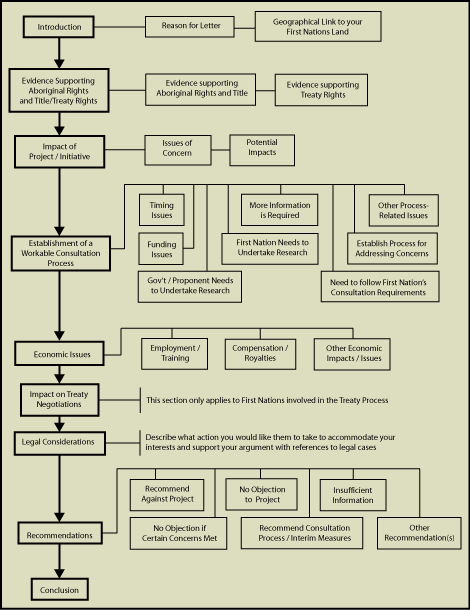The information provided on these pages is not a substitute for legal advice, but a few tools that you may find useful in developing your response to referrals.

First Nation guide for developing response letters
| Remember to read the section How to use the Toolbox. |
|
Before writing your response letter, it is important to form a clear position about the proposed project, as this will affect how your First Nation should respond to the referral. The purpose of a response letter may range from finding out more about the project, to ensuring that certain conditions are met if the project is to be approved, to complete opposition to the project, regardless of the details.
For example, if your First Nation could in principle support the project, but your support depends on how it will be carried out, the letter will serve the purpose of initiating a process for dialogue, studies, etc. Or, if your First Nation is completely opposed to the project, the purpose of the letter is to convince government that they should not approve it, and that if they approve it, their decision may be legally vulnerable.
Once your First Nation is clear about your goals, you will be clear about the purpose of the letter. In all cases, but especially for referrals where you are opposed to the project and want to prevent its approval, it is advisable to have your lawyer review your response letter before submission.
DON’T use the following guide for developing response letters as a template. This may sound contradictory. However, we think this is good advice for two reasons:
1) The guide is provided to be more of a check-list, to offer suggestions on language and to help you reflect on possible content for your own responses. Please don’t use it as a “fill in the blank” letter for all your responses – in so doing, you may weaken your position.
2) Remember, a detailed response to every referral that comes in the door may not be the most effective way for your Nation to achieve its goals and protect your Nation’s Aboriginal Rights and Title. Consider carefully where to devote the time and energy required to develop a response – choose your battles. Focus on the issues that matter most to your community.
How to use this response letter guide:
Here are examples of what you will see throughout this response letter guide:
|
Sample
|
Description
|
|
Bolded Text
|
These are instructions of what you may choose to provide for each section you are working on. This text should NOT be included in your letter.
|
|
<a sacred site / cultural area>
|
These are “Wording Alternatives” that you can choose from. They may not be relevant to your needs, but will give you some ideas to think about. Consider replacing these with your own wording!
|
|
[name of project]
|
These provide an “Explanation” of what type of information is required.
|
Components of a Comprehensive Response Letter
The response letter guide is divided into nine discreet sections, which are set out in the flowchart below. You may click on the headings to find out more information or begin your letter at the “Introduction” section and work through to the “Conclusion” section.



